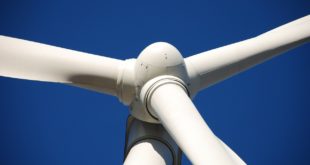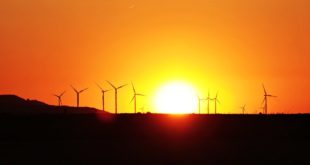Icebreaker’ Foundation adapts well-proven monopile design to address
Lake Erie’s soil conditions and harsh winters

The Lake Erie Energy Development Corporation (LEEDCo) announced today that it has completed a thorough analysis of four different conceptual offshore wind foundation designs and has selected the “monopile” concept to further develop for the Cleveland-based non-profit’s offshore wind project on Lake Erie.
“We picked the monopile design for the ‘Icebreaker’ Foundation after working with our world-class technical team to analyze Lake Erie’s unique wind, wave, icing and soil conditions and to identify ways to integrate global best practices,” said LEEDCo President Dr. Lorry Wagner. “Drawing on global expertise helps Northeast Ohio to be on the cutting edge of the emerging U.S. offshore wind industry.”
LEEDCo’s foundation design team includes some of the world’s leading experts on marine construction, ice load characterization and offshore wind installation. The team has collectively worked on more than a thousand offshore wind turbine foundation designs in Denmark, Finland, the UK, Germany, France and the USA.
Dr. Esa Eranti, an ice expert from Finland, has been designing structures in ice for more than 30 years and was responsible for building a similar offshore wind project, Pori 1 in the icy waters of the Northern Baltic Sea. His company, Eranti Engineering, performed the ice characterization analysis that informed LEEDCo’s design team about the expected ice loading conditions for the different foundation concepts.
“I don’t have to tell Clevelanders how tough the winters can be,” Dr. Eranti said. “While we can’t do anything to control the weather, we do know what it takes to keep the turbines operating in harsh conditions, including the North Baltic Sea. We are designing the Icebreaker Foundation to withstand Lake Erie’s harshest winters.”
The international consulting firm COWI and its American subsidiary Ocean and Coastal Consultants (OCC) have completed concept designs, tender designs, and detailed designs of foundations for more than 6,000MW of offshore wind turbines. In May, LEEDCo worked with OCC|COWI to analyze the results of a series of pressure tests and soil borings that the nonprofit performed on the lake bed at the site of the future offshore wind project. This analysis helped the LEEDCo design team better understand Lake Erie’s unique soil conditions.
“Every seabed is unique. We learned a lot through the initial geotechnical investigation that we conducted earlier this year,” said Joseph Marrone, PE, Vice President of OCC|COWI. “Lake Erie soil is a unique mix of clay, sand, glacial till and shale that is conducive to a modified monopile design. We will deploy innovative technology to help enhance the lake’s soil characteristics and ensure a stable foundation.”
Offshore Design Engineering (ode) is an engineering, construction and project management firm based in the UK with more than three decades of experience in the offshore oil and gas industry and 12 years of experience in offshore wind, during which time they have successfully managed the installation of a number of operating wind farms off the UK coast. Drawing on this extensive practical experience, ode assessed the installation and maintenance challenges for each foundation concept in order to help the design team better understand the costs and potential complexities.
“After evaluating various foundation concepts from an installation and maintenance perspective, we feel very confident that a monopile design will perform very well, and the installation and maintenance plan can be managed very effectively,” said Dan Woodman from ode. “The monopile technology is already well-proven in the North Sea, and our plan is to optimize the installation methods for Lake Erie conditions.”
LEEDCo’s unique “Icebreaker” Foundation will be more substantial than most European monopiles in order to withstand loads from large Ice keels. It will employ an “ice cone” attached to the foundation at the water level to break up large sheets of ice as they come in contact with the foundation. It will also include novel technology to enhance the Lake’s soil characteristics in order to increase stability.
“The selection of the monopile foundation is a significant technical milestone in LEEDCo’s effort to build an offshore wind power industry for the region,” said Dr. Wagner. “We are working to become the global experts on how to build offshore wind projects in icy conditions.”
The LEEDCo design team will now work to complete a more detailed engineering design to be submitted to the Department of Energy (DOE) by February 14, 2014, as part of an intense competition. Project Icebreaker is one of seven offshore wind demonstration projects nationally to receive a $4 million federal investment this year to complete the front-end engineering design and apply for all necessary permits. In May 2014, DOE will select three of those projects for additional investment of $46.7 million each.
Project Icebreaker consists of six 3.0 MW Siemens wind turbines in Lake Erie approximately seven miles off the coast of Downtown Cleveland. The project has the support of numerous local leaders, including Mayor Frank Jackson and U.S. Rep. Marcy Kaptur, as well as more than 7,000 individuals who have already pledged to buy a portion of their electricity from the project.
As the only DOE-funded project in the Great Lakes region, the LEEDCo team believes innovations incorporated into the Icebreaker Foundation will be crucial to future offshore wind development in the icy waters of the Great Lakes.
“The Great Lakes represents 18 percent of the total offshore wind resource potential in the United States,” said Dr. Wagner. “This region will be heavily impacted by coal plant closures; therefore, we have an urgent need to develop local clean energy alternatives that can achieve significant scale. Successful deployment of the Icebreaker Foundation could unlock the huge offshore wind potential for the entire Great Lakes region.”
 Alternative Energy HQ solar power for homes, wind energy, and bio fuel issues
Alternative Energy HQ solar power for homes, wind energy, and bio fuel issues






